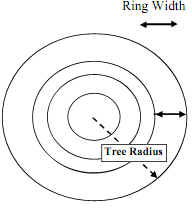Question: The age of a tree can be determined by counting the number of rings on its trunk. One ring is added onto a tree's trunk each year. Moreover, the width of each ring is random and depends on the amount of rainfall in that year. For example, the radius of a four year-old tree is R = X1 + X2 + X3 + X4 where {Xi} is a sequence of i.i.d. ring widths. Years can be classified as Wet, Dry, or Normal, each occurring with equal probability. The table below summarizes the conditional expected ring width (in inches) and its respective conditional standard deviation.

|
Annual Ring Width statistics
|
Wet
|
Dry
|
Normal,
0.33333
|
|
Probability
|
0.33333
|
0.33333
|
|
Expected Ring Width in Inches
|
3
|
1
|
2
|
|
Standard Deviation of Ring Width, in inches
|
1.5
|
0.5
|
1
|
You may invoke the Central Limit Theorem and the 68-95-99.7 rule.
a) Compute the expected value and variance of the ring width in a single year.
b) Compute the expected tree radius and its variance of a 50 year old tree.
c) Construct a 95% confidence interval for the radius of a 50-year tree. That is, find a range (a, b) such that there is a 95% probability that the radius of a 50-year old tree will be inside this range. Your interval should be centered on the expected radius of the 50 year old tree.
d) If fR(r) and FR(r) are the PDF and CDF for the radius, derive the distribution of the area of the cross section of a 50-year old tree (assuming that the cross section is a perfect circle). (Hint: you may give an answer in terms of either the PDF or the CDF of R. The area of a circle with radius r is Πr2. Note that r ≥ 0 and Πr2 is monotonic over this range).